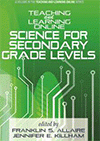
Teaching and Learning Online
Science for Secondary Grade Levels
Edited by:
Franklin S. Allaire, University of Houston-Downtown
Jennifer E. Killham, University of La Verne
A volume in the series: Teaching and Learning Online. Editor(s): Franklin S. Allaire, University of Houston-Downtown. Jennifer E. Killham, University of La Verne.
Published 2023
Science is unique among the disciplines since it is inherently hands-on. However, the hands-on nature of science instruction also makes it uniquely challenging when teaching in virtual environments. How do we, as science teachers, deliver high-quality experiences to secondary students in an online environment that leads to age/grade-level appropriate science content knowledge and literacy, but also collaborative experiences in the inquiry process and the nature of science?
The expansion of online environments for education poses logistical and pedagogical challenges for early childhood and elementary science teachers and early learners. Despite digital media becoming more available and ubiquitous and increases in online spaces for teaching and learning (Killham et al., 2014; Wong et al., 2018), PreK-12 teachers consistently report feeling underprepared or overwhelmed by online learning environments (Molnar et al., 2021; Seaman et al., 2018). This is coupled with persistent challenges related to elementary teachers’ lack of confidence and low science teaching self-efficacy (Brigido, Borrachero, Bermejo, & Mellado, 2013; Gunning & Mensah, 2011).
Teaching and Learning Online: Science for Secondary Grade Levels comprises three distinct sections: Frameworks, Teacher’s Journeys, and Lesson Plans. Each section explores the current trends and the unique challenges facing secondary teachers and students when teaching and learning science in online environments. All three sections include alignment with Next Generation Science Standards, tips and advice from the authors, online resources, and discussion questions to foster individual reflection as well as small group/classwide discussion. Teacher’s Journeys and Lesson Plan sections use the 5E model (Bybee et al., 2006; Duran & Duran, 2004). Ideal for undergraduate teacher candidates, graduate students, teacher educators, classroom teachers, parents, and administrators, this book addresses why and how teachers use online environments to teach science content and work with elementary students through a research-based foundation.
CONTENTS
Introduction: Teaching and Learning Online: Science for Secondary Grade Levels, Franklin S. Allaire and Jennifer E. Killham. PART I: FRAMEWORKS. Inquiry and Nature of Science in Digital Spaces, John L. Pecore and Lisa Martin-Hansen. Crosscutting Concepts: The Common Thread Often Hidden, Patrick Enderle, Scott Cohen, and Marissa Murdock. Issues of Diversity, Equity, and Inclusivity in Online Secondary STEM Education, Anne Mangahas. Empowering Secondary Teachers to Use EQuIP Rubric to be Critical Conscious Users of Online Science Curricular Materials, Amal Ibourk and Tina Cheuk. Engineering Design as a Framework for Virtual Education in Inclusive Science Classrooms, Amanda L. Mazin and Jessica F. Riccio. Bridging the Gap: Empowering Adolescent Girls in STEM Through Online Learning and Mentoring, Leslie Ekpe and Sarah Toutant. Supporting Claim-Evidence-Reasoning in Linguistically Diverse Secondary Science Classes, Preetha K. Menon. Giving Online Learning the Personal Touch: The Promoting Evidentiary Reasoning and Self-Regulation Online (PERSON) Framework, Robert B. Marsteller and Alec M. Bodzin. PART II: TEACHER’S JOURNEYS. Using Educational Technology to Foster High School Students’ Online Presence and Engagement as Becomings: An Integrated Stem Lesson on Trebuchets and Parabolas, Sophia Jeong and Stephen T. Lewis. A PhET Simulation Inquiry Lab on Energy Conservation: Modified for Remote Learning in High School, Trish Loeblein and Katherine Perkins. Active Learning at Home: Using 3D Virtual Reality Viewers to Explore the Human Heart for High School Students, Rebecca Hite, Gina Childers, and M. Gail Jones. Citizen Science to Engage Youth in Pollinator Conservation for the Social Good, Rita Hagevik and Kaitlin Campbell. Where Did My Food’s Food Come From? Nature Journaling as a Tool For Meaning-Making In Photosynthesis, Kelly Feille and Stephanie Hathcock. Design Thinking and Mini-Maker Kits in Science Education: Frameworks for Creative Problem-Solving in Transitions to Online and Hybrid Learning, Helen Douglass and Isaiah Darden. PART III: LESSON PLANS. Exploring Regional Climates with 360-Degree Photo Spheres, Matthew Clay. Scientific Modeling in a Virtual Setting: Floating and Sinking Pennies! Sophia Jeong and David Pauli. Digging Into Rocks & Minerals Through Science Olympiad’s MY SO Program, Lucas Gobel, John Loehr, and Katrina Pavlik. A Look Inside the Atom: The Basic Building Block of Matter and the Foundation in an Online Science Course, Natasha Hillsman Johnson and Sophia Jeong. When Things Move With Constant Velocity and Acceleration, Philomena N. Agu. Using Scaffolding to Develop Evidentiary Reasoning: A Simulation-Based Approach to Teaching Biological Evolution Online, Robert B. Marsteller and Alec M. Bodzin. Climate Crisis Issues in Our Community, Amy Vo. Exploring Digital Inclusive Pedagogy in Action in a High School Physics Class: Analyzing and Interpreting Force and Motion, Jessica Riccio, Amanda Mazin, and Ibrahim Dincer. Stability and Change: Wildfires and Ecosystem Succession, Marissa Murdock, Scott Cohen, and Patrick Enderle. How Does CO2 Interact With Water To Make It More Acidic? Lorna Otero, Juliet Octavius, Amanda Mazin, and Jessica Riccio. A Case of Violet’s GLUT1: What is Wrong with Violet? Sophia Jeong, Jennifer Yauck, Sarah Robinson, Patricia Zagallo, and Paula Lemons. Biographies.
-
Paperback979-8-88730-127-3
Web price: $62.04 (Reg. 72.99)
-
Hardcover979-8-88730-128-0
Web price: $89.24 (Reg. 104.99)
- eBook979-8-88730-129-7

- EDU025000 - EDUCATION: Secondary
- EDU029030 - EDUCATION: TEACHING METHODS & MATERIALS: Science & Technology
- EDU041000 - EDUCATION: Distance & Online Education
-
 360-Video and Remote Exploration
360-Video and Remote Exploration
-
 Digital Technologies and Early Childhood in China
Policy and Practice
Digital Technologies and Early Childhood in China
Policy and Practice
-
 Distance Learning
Volume 20 #4
Distance Learning
Volume 20 #4
-
 Embracing Artificial Intelligence in the Classroom
Embracing Artificial Intelligence in the Classroom
-
 Polling Student Voices for School Improvement
A Guide for Educational Leaders - 2nd Edition
Polling Student Voices for School Improvement
A Guide for Educational Leaders - 2nd Edition
-
 Teaching and Learning Online
Science for Elementary Grade Levels
Teaching and Learning Online
Science for Elementary Grade Levels
-
 Teaching and Learning Online
Mathematics for Early Childhood and Elementary Grade Levels
Teaching and Learning Online
Mathematics for Early Childhood and Elementary Grade Levels

